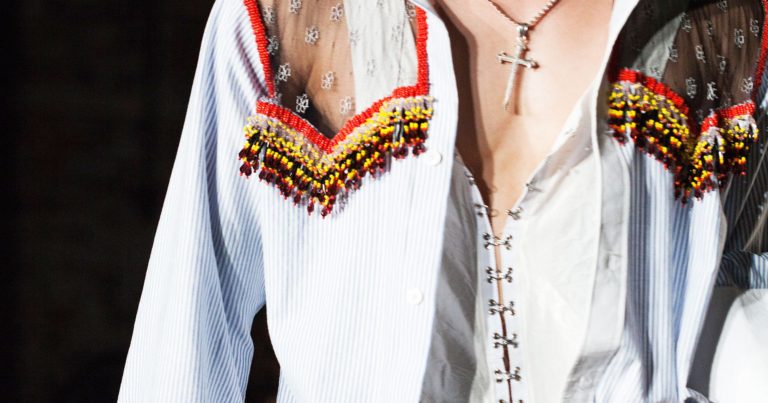

Kenneth Nicholson
What is your brand’s ethos?
“At the core of the brand lies my passion to create beauty, specifically beautiful menswear. Beauty comes in a vast array of elements both soft and hard, light and dark. Centuries of menswear have expressed beauty without limiting the wide range of silhouettes and techniques available to them, and we, now in the modern era, should allow men the permission to express themselves in the same manner without ridicule or restrictions.
“We now find ourselves in an era in which menswear consists of a few options: pants, shorts and shirts. With my ‘Lover From The Bath’ collection, there is lace on collars and cuffs and delicate cloth-covered buttons. There are tunics, ribbon sashes, ornamental jeweled buttons, as well as hard canvases and heavy denims with velvet, gilded crows. To me, this is truly what menswear today is lacking as it steeps itself in its own limitations bound in labels, which no longer reflect the vast majority of our current society.”
What is your observation of the cultural shift the fashion industry is having right now, and whether that has to do with sexuality, gender or diversity? Is it a fad?
“As a Black, male child growing up in the South, I think the visuals of beauty and the idea of what was often touted as pleasantly beautiful seemed to always linger in the distance. For me, whether it was seeing the beauty in freshly snipped flowers on a dining table, a ribbon in the hair of a girl that sat in front of me in Sunday school and the lace details in her yellow tulle dress, or the opulence of an orchestra led by an opera singer belting the most tragically beautiful song in a floor-length gown, this imagery struck me. It struck me as not only beautiful but also non-gendered.
“Being that I was so compulsively inspired by elements, which were somehow wrought in expressions of femininity, definitely set me on a path to be at odds with elders and peers. Additionally, as a Black, straight male in the midst of traditional Southern culture, being told my leanings were out of step always seemed to keep a wedge between me and the full range of access to sartorially and artistically self-express. When designing for collections and conceptualizing brand imagery, the recurring goal is to move the brand into the future while keeping a stronghold on what we’ve started, but also placing elements that are often idealized as feminine and positioning them in direct proximity of the Kenneth Nicholson man.”
What is your observation of the cultural shift the fashion industry is having right now, and whether that has to do with sexuality, gender or diversity? Is it a fad?
“I’m hopeful that the shift we’re seeing is authentic. It’s my observation that usually enduring changes have their genesis at a grass roots level. Very rarely do ideas that come into common practice, especially those which edify the public, begin with the trickle down theory. With this being the case, I don’t think we’re merely experiencing a trend. I believe we’re experiencing a shift.”
What will it take for mainstream brands to embrace what yours and so many emerging labels do? Do we even want that?
“Mainstream brands will have to embrace what society is evolving into to meet the demands of their customer base. Foundations of what generations past deemed the standard are being challenged as the voice of the new generation begins to shift into positions of highest authority and influence. The baton is being passed in a momentous way and those who don’t expand with culture will eventually become irrelevant.
“I would, however, like to see mainstream brands stay true to the purity of the content being expressed and not utilizing it in any way that’s inauthentic of the culture.”
What does your brand offer in this space that no one else does?
“As an emerging designer, I understand that there are many traditions and established foundations that have been laid before me. It’s a duty to be able to speak to that through my design process. Techniques like bias cutting, draping, slash-and-spread, to name a few, are all techniques that I look forward to utilizing for the type of garments I seek to construct. My lived experience, my perspective, and expression are extremely unique. Altogether, the spirit of Kenneth Nicholson offers a fresh vision forward, guided by respect and discipline of the craft.”
Has queerness found its place in high-fashion? If so or if not, why?
“The idea of embracing gender fluidity has been around in the fashion industry for some time now and seems to be garnering more attention. It seems as with each new generation there’s a bigger inhale, so to speak, which results in an even greater exhale of new ideas and inclusion. So while there are more images of nontraditional binary brands and models [coming up], I think it’s still the beginning of a chapter.”